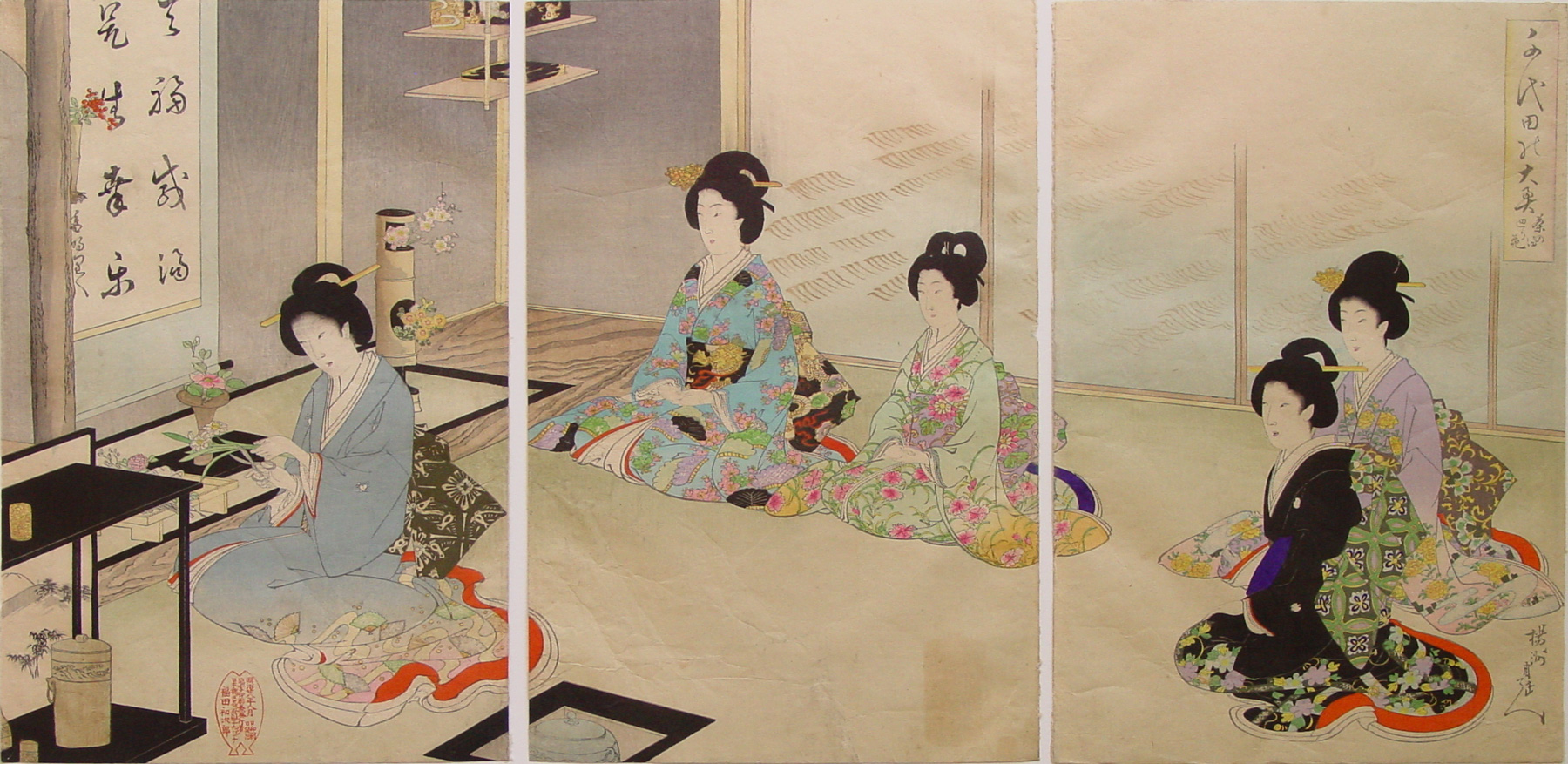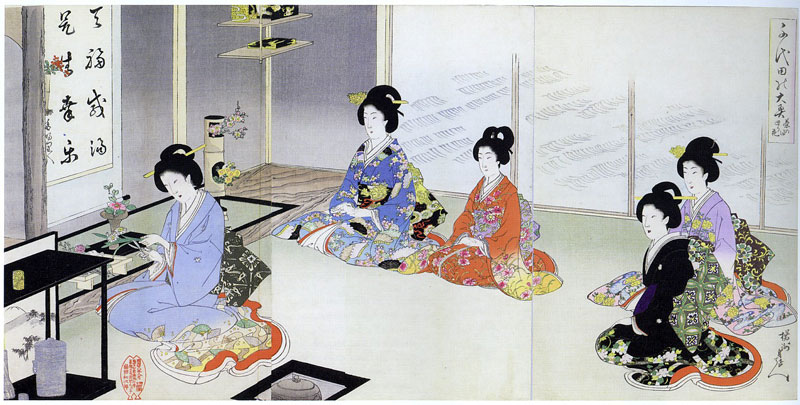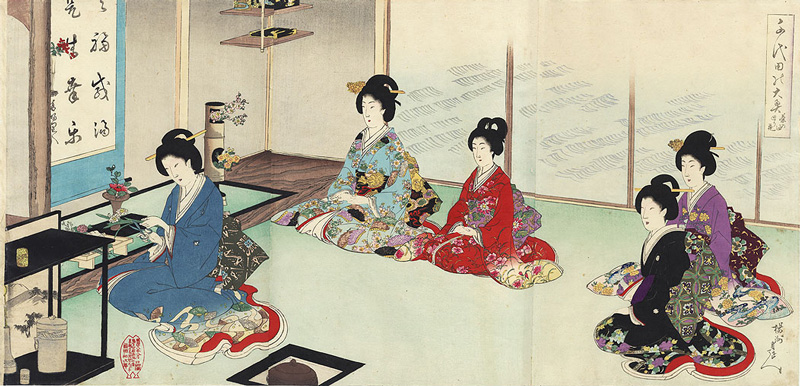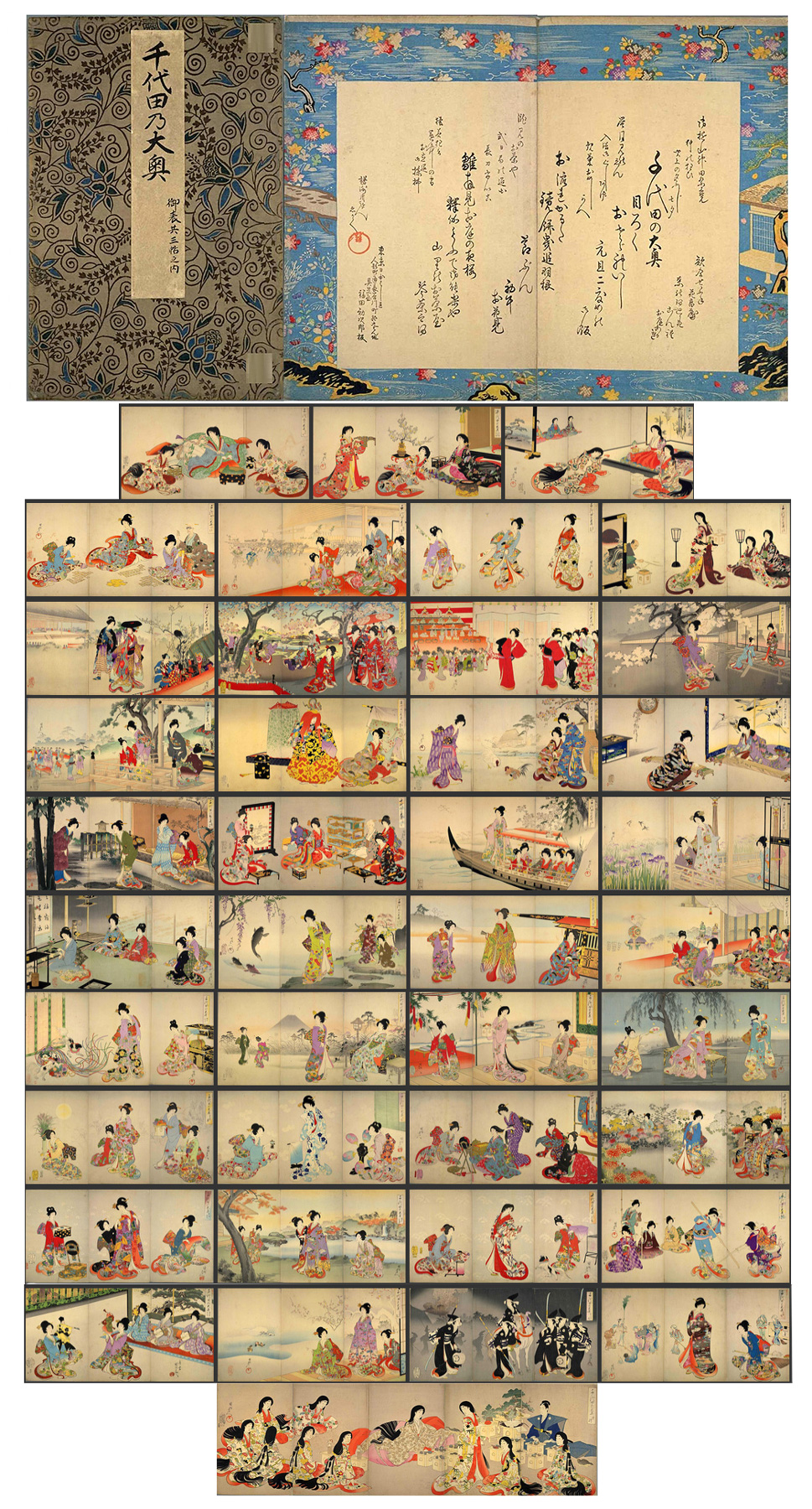About This Print
This print, from a series of 40 scenes documenting life inside the women quarters of the shogun's palace in Edo prior to the Meiji Restoration in 1868, brings us two of the cultured arts practiced by the court ladies of the palace - flower arranging and tea ceremony, as further discussed below.A number, if not all, of the prints in this popular series went through multiple re-printings. At lease three color variants for this print are known.
Source: Chikanobu – Modernity and Nostalgia in Japanese Prints, Bruce A. Coats, Hotei Publishing, 2006, p. 169, 176.
The palace was a world in itself, with woods and gardens, streams and red-lacquered pleasure barges. There the women amused themselves with poetry-writing competitions, tea ceremonies, the incense-guessing game and the shell-matching game. They performed plays and masques and observed the annual festivals, feasting under the cherry blossoms in spring, performing graceful dances at the height of summer and picking mushrooms in autumn.
Chiyoda Castle (千代田城, Chiyoda-jō) also known as Edo Castle (江戸城, Edo-jō), is a flatland castle that was built in 1457 by Ōta Dōkan. It is located in Chiyoda in Tokyo, then known as Edo, Toshima District, Musashi Province. Tokugawa Ieyasu established the Tokugawa shogunate here. It was the residence of the shogun and location of the shogunate, and also functioned as the military capital during the Edo period of Japanese history.
After the capitulation of the shogunate in 1867, the inhabitants including the shogun had to vacate the premises. The castle compound was renamed Tokyo Castle (東京城, Tokyo-jō) in October, 1868, and then renamed Imperial Castle (皇城, Kōjō) in 1869. In the year Meiji 2 (1868), on the 23rd day of the 10th month, the emperor moved to Tokyo and Edo castle became an imperial palace.
1 Portland Art Museum http://portlandartmuseum.us/mwebcgi/mweb.exe?request=record;id=46772;type=101
| Chiyoda Inner Palace: Flower Arranging in Turn Scripps College 2003.1.15 | Chiyoda Inner Palace: Flower Arranging in Turn |
In the 3rd month of the year, special tea ceremonies were held in the Inner Palace when guests and hosts played sophisticated games, such as guessing which types of tea were being served, or exchanged roles. In mawaribana guests took their turn arranging flowers appropriate to different moments of the ceremony, choosing among cut flowers and vessels that had been set out by the host. This type of performance art required quick thinking and steady nerves, as everyone else intently watched. Here three younger women and an older lady (dressed in black silk robes) quietly observe a middle-aged woman carefully cutting flower stems. Two bamboo containers have already been provided with flowers, the standing bamboo stalk with openings cut for flowers and the hanging bamboo joint with red berries.
Set into the tatami matted floor in the foreground is a square hearth (ro) with a lidded water kettle and to the left side is a formal black lacquered preparation stand (daisu) to hold items for the tea ceremony, including the silver cold water jar and the gold-colored liquor (maki-e) tea caddy (natsume) on the top shelf. In the alcove (tokonoma) is a hanging scroll of calligraphy, and several pieces of lacquerware are displayed on the adjacent shelves. The sliding wall panels (fusuma) are decorated with waves printed with silver dust.
Life in the Palace
Source: Secrets of the Shogun's Harem, Leslie Downer http://www.lesleydowner.com/journalism/secrets-of-the-shoguns-harem/The palace was a world in itself, with woods and gardens, streams and red-lacquered pleasure barges. There the women amused themselves with poetry-writing competitions, tea ceremonies, the incense-guessing game and the shell-matching game. They performed plays and masques and observed the annual festivals, feasting under the cherry blossoms in spring, performing graceful dances at the height of summer and picking mushrooms in autumn.
About The Series
click on image to enlargeAfter completion of the series in 1896 the publisher compiled albums of all forty prints, plus a table of contents. "In the series "The Inner Precincts of Chiyoda," Chikanobu imagines something he never saw—the inner precincts of Edo Castle, which housed the shogun’s mother, wife, and concubines. The area was off limits to all men other than the shogun himself or his young male heir."1
"The Chiyoda Inner Palace (Chiyoda no Ōoku) series of 1895-1896, together with his 1897 series Chiyoda Outer Palace (Chiyoda no on-omote) provided detailed depictions of life in and around Edo Castle before the Meiji Restoration of 1868. In the Chiyoda Inner Palace set, Chikanobu documented various annual ceremonies in the women’s quarters, especially those at New Year’s, and seasonal activities, particularly those conducted in the palace gardens. While Chikanobu did not indicate specific events or name certain people that would link these images to a single date or time period, the scenes give an overall impression of what the shogun’s private quarters might have looked like in the mid-19th century.
"Most women depicted in Chiyoda Inner Palace are portrayed as elegant dignified ideal feminine figures, showing little emotion or excitement. No one seems happy or sad, ebullient or upset. In fact, these imaginary depictions suggest a realm of tranquil harmony, without conflict or illness. Only two old women are shown, and most of the more than 150 featured figures are youthful looking, appearing to be in their 20’s or early 30’s. A few girls are present, but even they are well behaved; no babies or pregnant women are evident. There is a sense of tension among the women, though, as ritual gestures and prescribed ceremonies are carried out with great seriousness. Although some settings are animated by secondary figures (servants,
actors, parade participants, etc.) or pet animals, overall the quiet rhythm of life in the Chiyoda Inner Palace is predominant and well described."2
click on image to enlarge After completion of the series in 1896 the publisher compiled albums of all forty prints, plus a table of contents. | "In the series "The Inner Precincts of Chiyoda," Chikanobu imagines something he never saw—the inner precincts of Edo Castle, which housed the shogun’s mother, wife, and concubines. The area was off limits to all men other than the shogun himself or his young male heir."1 "The Chiyoda Inner Palace (Chiyoda no Ōoku) series of 1895-1896, together with his 1897 series Chiyoda Outer Palace (Chiyoda no on-omote) provided detailed depictions of life in and around Edo Castle before the Meiji Restoration of 1868. In the Chiyoda Inner Palace set, Chikanobu documented various annual ceremonies in the women’s quarters, especially those at New Year’s, and seasonal activities, particularly those conducted in the palace gardens. While Chikanobu did not indicate specific events or name certain people that would link these images to a single date or time period, the scenes give an overall impression of what the shogun’s private quarters might have looked like in the mid-19th century. "Most women depicted in Chiyoda Inner Palace are portrayed as elegant dignified ideal feminine figures, showing little emotion or excitement. No one seems happy or sad, ebullient or upset. In fact, these imaginary depictions suggest a realm of tranquil harmony, without conflict or illness. Only two old women are shown, and most of the more than 150 featured figures are youthful looking, appearing to be in their 20’s or early 30’s. A few girls are present, but even they are well behaved; no babies or pregnant women are evident. There is a sense of tension among the women, though, as ritual gestures and prescribed ceremonies are carried out with great seriousness. Although some settings are animated by secondary figures (servants, |
Chiyoda Palace History
Source: Wikipedia http://en.wikipedia.org/wiki/Edo_CastleChiyoda Castle (千代田城, Chiyoda-jō) also known as Edo Castle (江戸城, Edo-jō), is a flatland castle that was built in 1457 by Ōta Dōkan. It is located in Chiyoda in Tokyo, then known as Edo, Toshima District, Musashi Province. Tokugawa Ieyasu established the Tokugawa shogunate here. It was the residence of the shogun and location of the shogunate, and also functioned as the military capital during the Edo period of Japanese history.
After the capitulation of the shogunate in 1867, the inhabitants including the shogun had to vacate the premises. The castle compound was renamed Tokyo Castle (東京城, Tokyo-jō) in October, 1868, and then renamed Imperial Castle (皇城, Kōjō) in 1869. In the year Meiji 2 (1868), on the 23rd day of the 10th month, the emperor moved to Tokyo and Edo castle became an imperial palace.
1 Portland Art Museum http://portlandartmuseum.us/mwebcgi/mweb.exe?request=record;id=46772;type=101
2 Chikanobu – Modernity and Nostalgia in Japanese Prints, Bruce A. Coats, Hotei Publishing, 2006, p. 169.
last revision:
Print Details
| IHL Catalog | #130 |
| Title or Description | Tea Ceremony Flower Arranging in Turn Chanoyu mawaribana 茶の湯廻り花 |
| Series | Chiyoda Inner Palace Chiyoda no Ōoku 千代田の大奥 |
| Artist | Yōshū Chikanobu (1838-1912) |
| Signature |  |
| Seal | no artist's seal |
| Publication Date | August 1895 (Meiji 28) |
| Publisher |  [Marks: pub. ref. 070; seal ref. 062] |
| Impression | excellent |
| Colors | excellent |
| Condition | fair - medium soiling; creasing; backed but not joined; transfer stains; trimmed to image |
| Genre | ukiyo-e |
| Miscellaneous | |
| Format | vertical oban triptych |
| H x W Paper | 13 7/8 x 9 1/8 in. (35.2 x 23.2 cm) each panel |
| Literature | Chikanobu – Modernity and Nostalgia in Japanese Prints, Bruce A. Coats, Hotei Publishing, 2006, pl. 102, p. 176. |
| Collections This Print | Scripps College (SC2003.1.15); The Metropolitan Museum of Art JP3539.1, .2; Museum of Fine Arts, Boston (RES.51.84-6); Tokyo Metropolitan Library 618-C001- 004; Ritsumeikan University ARC国会668-00-063 国会668-00-062 国会668-00-061; Rhode Island School of Design Museum 85.197.14A-C |
4/25/2020





